DIY Mosquito Trap: For Peaceful Itch Free Camping
Any experienced backpacker has been stuck in the same situation, you are out in the high country, a day into your hike, and the mosquitos won’t stop biting your neck. You finally are ready to set up camp and you realize that in your desire to save money and space you opted out of a mosquito trap.
Now you are smacking your head in regret and also to scare off another biter. Don’t fear, we have a DIY mosquito trap just for you, you can find most of the products around your house or purchase for a very low price at any grocery store.
[the_ad_group id=”21″]
Our mosquito trap offers a chemical free and easy to pack along alternative for you to use. Whether you are hiking way up in the alpines, picnicking on a beautiful day outside, or sharing a glass of wine at twilight we can help you enjoy a mosquito free evening.
With this easy homemade mosquito trap you can impress your friends and stop slapping at your skin to avoid these little blood suckers.
Reasons for A Mosquito Trap
Before we jump directly into the how to section, there are a few reason to always have a mosquito trap with you. In some areas, mosquitos carry illnesses that include malaria, West Nile Virus, and yellow fever, many of which are deadly if they go untreated.
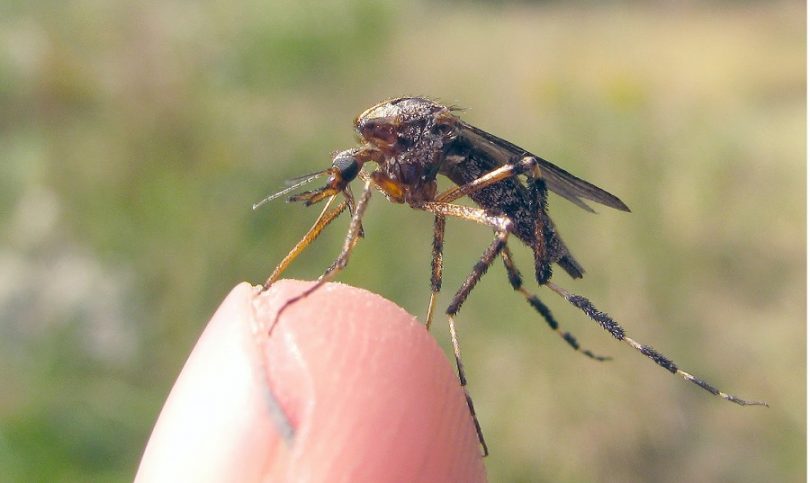
Certain areas, that are popular for both hiking and camping, are in the warning zone, meaning the mosquitos in these areas are likely to carry such diseases.
On top of this, in recent news, mosquitos in certain areas of the world have been linked to the Zika Virus which can lead to rashes, conjunctivitis, muscle pain, and later on abnormalities in pregnancy.
If you find yourself in a hot and humid climate than you are in a mosquito’s favorite place. Many will not survive in temperatures that are consistently below 50 degrees and tend to hibernate in the winter when it is cold and there are high winds, mosquitos can’t fly in winds over 1 mph.
While we all love shedding layers of clothes to bask in the sunlight, this is the time that mosquitos are most active, coming out at dawn and dusk when it is just the right temperature, and there is plenty of moisture in the air.
As many of us know, it is easy to get a tiny bite from one of these bugs, but the consequences can go far beyond a scratchy spot. If you have ever felt like all the mosquitos in the world are focused on you, you are not alone. Female mosquitos pick their prey based on a few qualities you can’t necessarily control.
Factors like your blood type, how much CO2 you are exhaling on average, the amount you sweat creating lactic acid, the bacteria on your skin, and even cracking open a beer after a long day of hiking can draw these bloodsuckers closer to you than the friends that you go hiking with.
This is why traps can be one of the most effective ways to protect yourself. While sprays and oils help, mosquitos have specifically hunted you down for your scent and can not only see you but can sense the heat rising off your body.
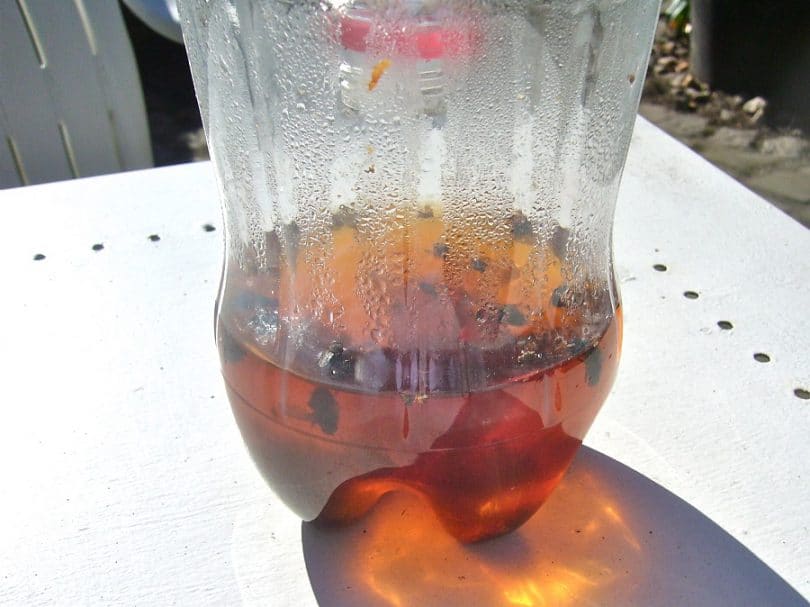
This trap will help grab the female mosquitoes before they even have a chance to bite, as only the females bite because they use the protein in your blood to produce and lay their eggs. Both the males and female mosquitoes are actually drawn to sweet nectar.
Regardless if you have a trap or not, make sure to check for any warnings about disease-carrying mosquitoes in the areas you plan on backpacking through. If there are, bring our trap along, some mosquito repellent, and make sure that you have netting for your tents.
What You Need
- 2 Liter Plastic Soda or Water Bottle
- Box Cutter or Scissors
- Ruler
- Marker
- 1 Cup of Water
- 1 Teaspoon of Active Dry Yeast
- ¼ Cup of Brown Sugar
- Black Duct Tape
- Camp Stove or Kitchen Stove to Heat Water
- Small Saucepan
Useful Tip: This solution should be used and changed out every two weeks, or else you will be creating an incubator for mosquitos and their potential hatchlings.
The black duct tape, operates as a mosquito magnet, they are very attracted to the heat retained by the color black and will be drawn to this instead of your neck, hands and arms!
A How-to Break Down
Step 1
Take your plastic 2-liter bottle and cut it in a way that you separate 1/3 of the top away from 2/3 of the bottle as smoothly as possible with either a box cutter or a pair of scissors, whichever is available to you.
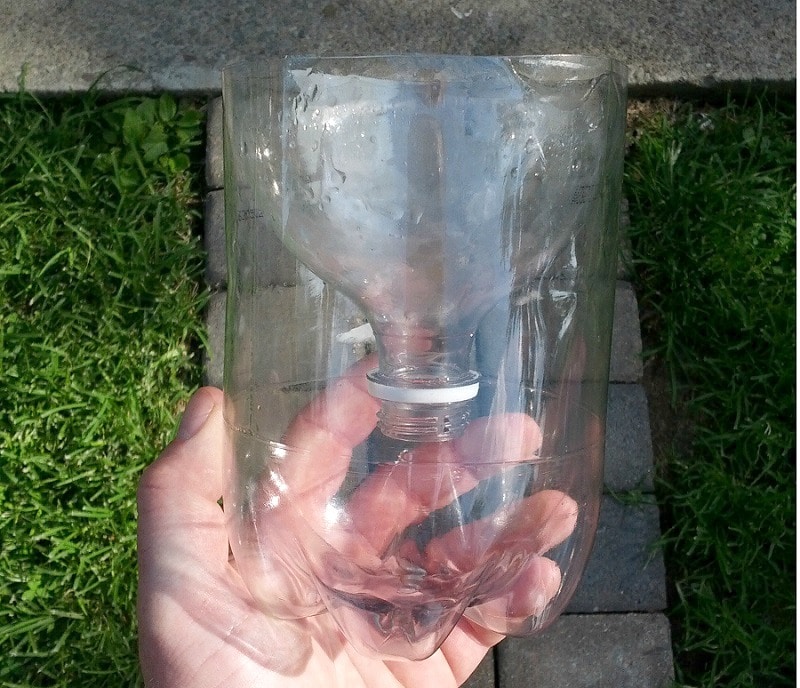
*Useful Tip: Before you go to the great outdoors, measure your bottle with a ruler, go up to 5” and mark the area, this way you can be assured that the top won’t fall through the bottle and that you can catch optimal amounts of mosquitos.
[the_ad_group id=”22″]
While you are cutting, to make an even cut, draw dots around the top an inch apart until you are all the way around. Draw a line, and cut with either a box cutter or scissors to get an even line.
Step 2
Heat up your cup of warm water on your camp or kitchen stove, and allow the water to boil.
Step 3
Mix in the ¼ cup of brown sugar until the sugar is completely dissolved, and then place the yeast into the mixture, as well. Make sure it cools down, before proceeding to the next step. You can add a cup of cold water if you need it to cool down faster.
Step 4
At this point allow the yeast to be added and bloom, your water needs to be around 105 to 115 degrees Fahrenheit in order for this to work. To put that in perspective, boiling temperature is 212 degrees Fahrenheit, and on high temperature takes about 5 to 10 minutes to boil. This is a bit tricky because it can not go down below 90 degrees Fahrenheit, or it will be too cold and the yeast will die.
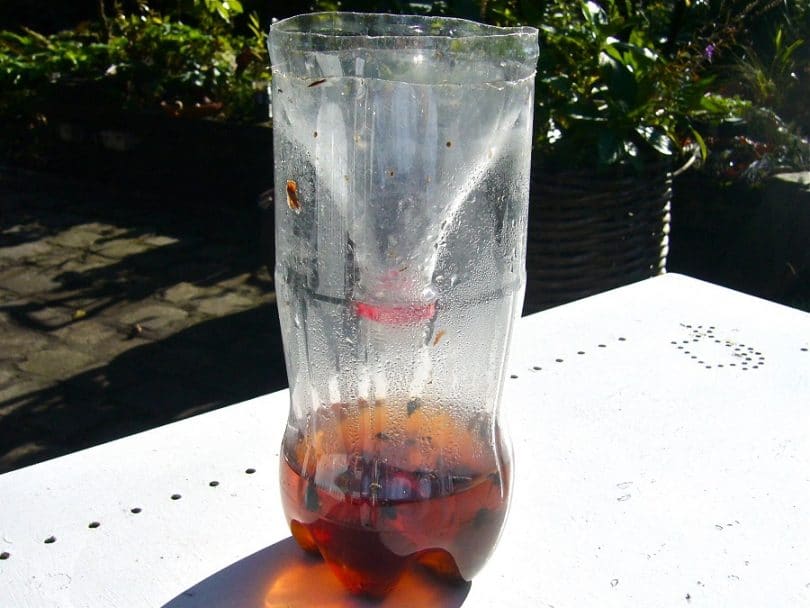
*Struggling with this? Test the water on your wrist if a thermometer isn’t available to you. While this step will be a bit sticky, the water should be a bit colder than your body temperature, your wrist is the most accurate part of your body to gauge temperature.
Step 5
The top part of your bottle should have the cap removed. Now take the bottle and turn it over, it will act as a funnel for our sugar mixture. Place the bottle upside down, grab your black duct tape and adhere the two parts together.
The liquid might touch the top of the bottle’s lip, if you added cold water to the mixture, pour some out so that there is enough space for mosquitos to come in. If black duct tape is out of your budget or reach, use black trash bags instead of black construction paper. The construction paper will wear over time, and we are looking for the black color to attract and retain heat and draw in mosquitos.
Step 6
When you are placing the mosquito trap, if you have the room, place it farther away from your picnic area or campsite if possible.
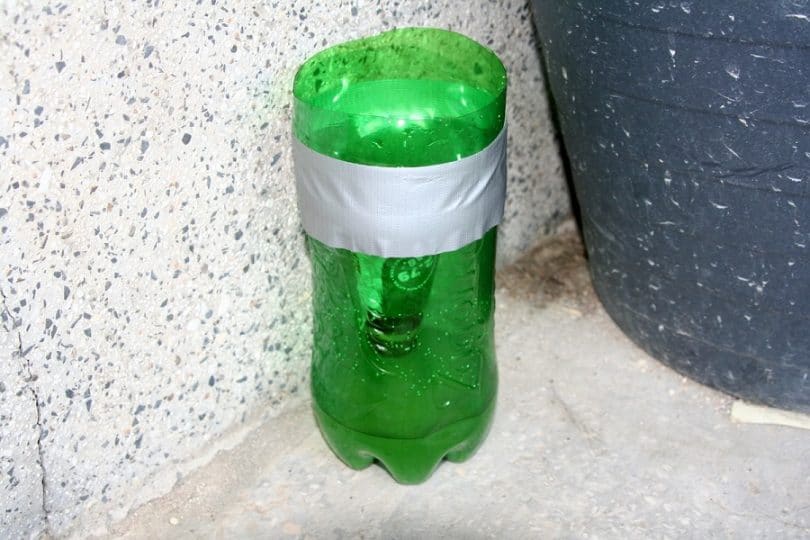
The trap area will have an increased density of mosquitos, so you don’t want it directly next to you.
Step 7
Replacement of the yeast and sugar mixture can be a little tricky. You will need to replace it every two weeks, or even every few days depending on the population of mosquitos. If you are no longer fermenting your yeast, meaning that the mixture is no longer bubbling, then you need yeast is finished and Carbon Dioxide is not being produced.
While you can chuck the whole thing out, you can also take a knife and slice the black tape pouring out the mixture and the dead bugs, and replace it with a new batch.
Useful Tip: To make this effective trap even more powerful, pre-paint the bottle black along the bottom half. Not only will this attract mosquitos closer, but it will also hide the mosquitos trapped in the bottom from sight so you can enjoy your picnic without staring at frantic mosquitos.
So How Does This Work?
The mosquito trap that we are using here is working on the research of what mosquitos are attracted too. Unfortunately, mosquitos have a better survival track record, with over 175 known species in the United States alone.
Mosquitos can also hunt out their next meal from over fifty meters away, a good thing to keep in mind when you are picking your final sleeping spot or setting up a romantic picnic for two. They also use the trifecta of hunting to land on your arm, using visual, olfactory and thermal cues to dig into to their next meal.
First they sense the CO2 that you are the vigorous hikers next to you, as they fly closer mosquitos use their advanced sight to see your body size and determine you as prey, and finally, as they close in, they are looking for your heat signature to determine you as a viable option. We use yeast to activate carbon dioxide, which is an attractive scent to a little mosquito looking for its next meal.
The sugars help activate this yeast, but also creates the sweet nectar smell that females are looking for to eat. These traps help capture the female mosquitos, not just using the CO2 but the water helps attract them in through moisture. As we mentioned before, females are the ones that bite you to help create their eggs.
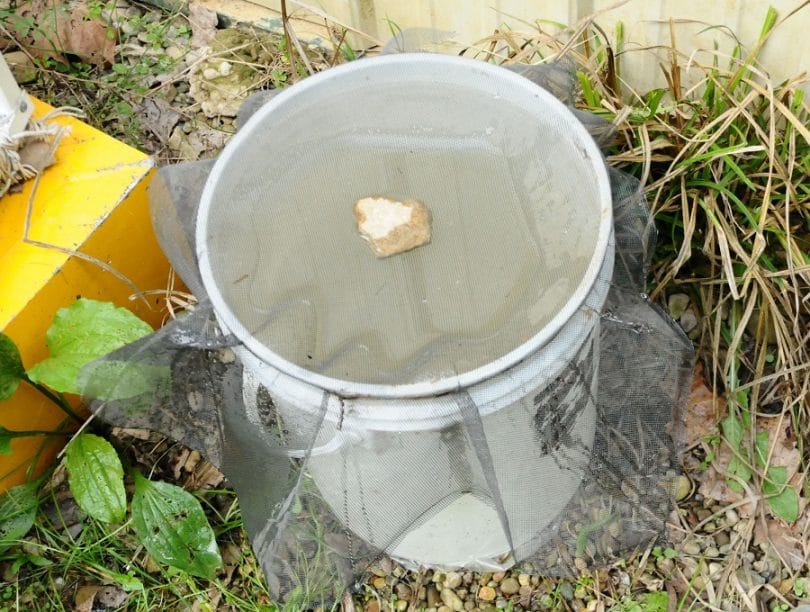
To calm any concerns around the ability for mosquitos to fly out of the cap opening they originally came in, luckily the female mosquitos will be confused by the Carbon Dioxide released. Also when they fly in the mosquitos get easily confused and lose their sense of direction rather easily and can’t find their way back out.
Another reason this particular trap is effective is the way that female mosquitos hunt for their meals. Mosquitos are most attracted to high levels of Carbon Dioxide in the air, if you have ever found yourself huffing and puffing your way up a mountain, covered in mosquitos, then you know this to be too true.
If you are finding your trap to be less effective than you originally hoped, add a bit more yeast to your mixture, and more sugar. The yeast as it blooms is eating up the sugars and creating the CO2 that mosquitos are interested in. The black coating is trapping in lots of heat, and they use special vision from their multilayered lens and spot their next meal using the thermal sensor information to detect heat.
Useful tip: The most effective traps are traps placed correctly. You need to place them in shaded areas that are half way between the source of the mosquitos and where you plan on camping or eating. If you are struggling to find the source of the mosquitos, especially if you are in your home, there are a few ways to find them:
- Is there any standing water near your property? Gutters not drained, or swamp-like water pools around your house that is a great place to start. Especially if it gets above 50 degrees Fahrenheit.
- Keep an eye out for a large clustering, they typically come out in the morning or in the evening twilight hours, when it isn’t too bright and there is high humidity making it moist enough for them.
- Check your plants indoor and outdoors that are potted, if you over water even a little bit, you create standing water perfect for a female mosquito to lay her eggs. You will see little wiggly larvae in the pot, make sure to clean the water tray out immediately.
- If you are outside, try not to camp directly next to water sources like lakes or water pumps, bathrooms, and any damp areas.
- Finally, do you have a basement or a crawl space? If you have pipes in these areas, check for leaks in those areas that can create stale standing water. These small spaces with standing water can have the same breeding ground benefits as a large swampy marsh.
If you are looking for an alternative trap that you can buy in stores, there are quite a few chemical based options for you to choose from, especially if you find yourself near an electrical outlet. There are quite a few traps on the market, heat, traps, CO2 traps, UV indoor traps, and propane traps.
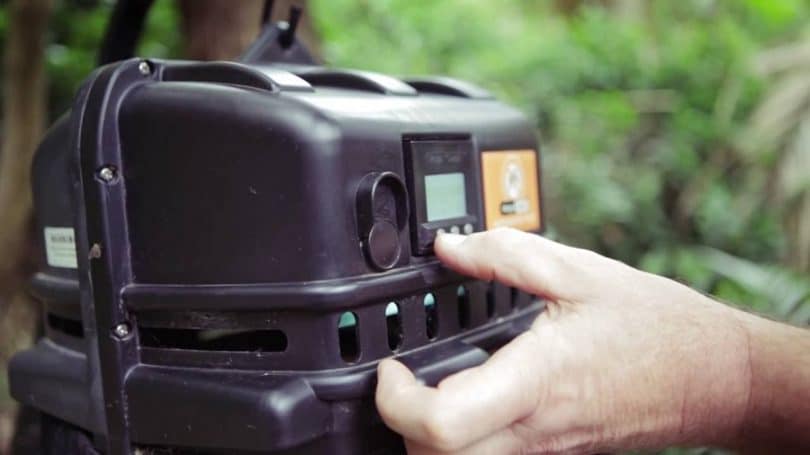
One of the best-rated mosquito traps on the market is very different from our DIY mosquito trap, it is the Mega-Catch mosquito trap, coming in at a whopping $349, that covers 1.5 acres with its ability to attract and kill mosquitos. It is a heat trap and essentially imitates the different ways humans behave that are bait like for mosquitos.
[the_ad_group id=”23″]
A bit loud and bulky, this trap can easily be utilized in your house but might be a bit more difficult to bring on a backpacking outing. In addition, unlike our DIY trap, where you can feel free to throw away after it becomes full with mosquitos, these traps need to be cleaned out of the debris before being fully effective.
Other than traps, if you know you are particularly susceptible to a mosquito bite, you can purchase sprays and nets to lay over your campsite. Online you can find many mosquito nets (like the ones sold by our friends on usnetting.com), and even canopies to keep the feel of a cute picnic, but keep you and your partner bite free.
Don’t Let Them Bite You!
Whether you are trekking through a forest or setting up a picnic spot by a lake, you are going to want to bring along some form of mosquito repellent, traps, or nets. One little bit by the wrong bug can lead to illness and discomfort. Do check out review of the top mosquito repellents to help you with more options.
If you have found that the mosquitos are warned to carry diseases, take several of our trap devices with you, especially if you are camping next to bodies of water.
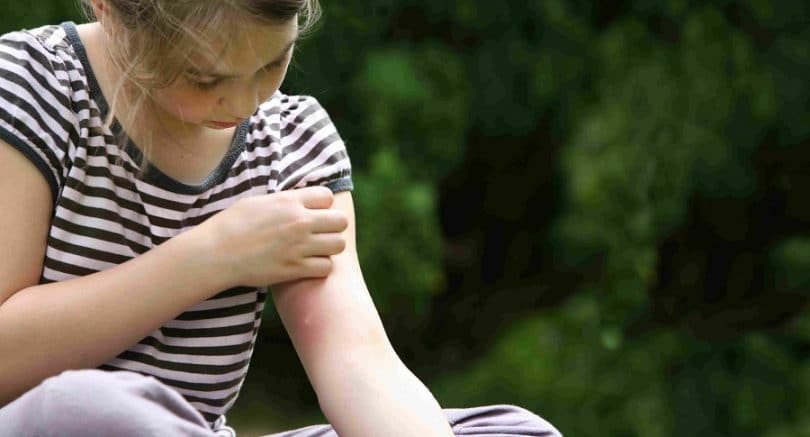
While no method is 100% effective, using multiple types of repellent, traps, sprays, bug lights, etc. can help make sure that you and your loved ones are safe from itchy and dangerous bites perhaps you are using our trap not because you can easily make it at home, but because you are looking for a natural remedy. For more natural repellents that work, check out our easy instructions on how to make mosquito repellents for your needs.
While DEET is a popular and well-known mosquito repellent that can be applied on your body or around a campsite via spray, it has health concerns due to its chemical compounds. In addition to our homemade mosquito trap, try using the natural lemon-eucalyptus oil on areas you are likely to bite. If you have had any success with our trap or have a different trap you love, let us know in the comments below!
Going camping? See our article on the top hammocks with mosquito nets to keep you safe and itch-free.

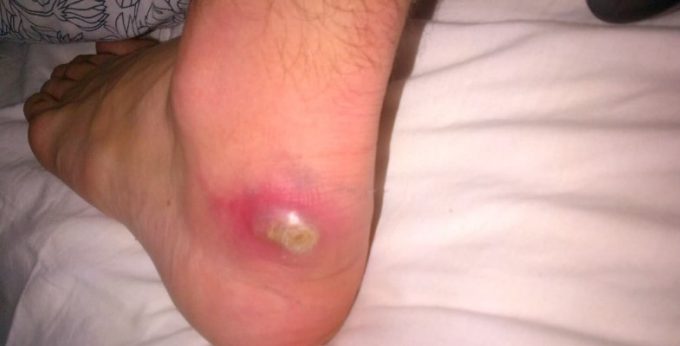

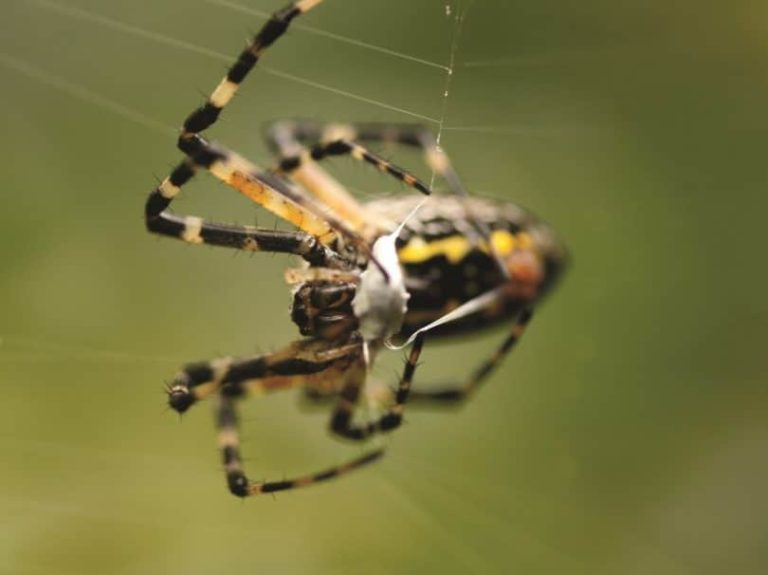


Very useful article, thank you! I’ve seen these traps used in the past at campsites and even in people’s gardens in areas with high concentrations of mosquitoes and they do seem to work really well if used correctly. I attempted to use one at a makeshift campsite on a recent backpacking trip and although it was effective (I was able to see a number of mosquitoes the next morning), I then fell into a trap myself. How do I move it on to my next campsite? Do you have any recommendations to make this a little more portable or easy ways to clear them out quickly without being bitten to death in the process?
Portable mosquito traps can be utilized, and you can make several of them to significantly improve the coverage. Just make sure you bring enough bottles. Portable traps are definitely easier to mobilize and can be completely customizable when it comes to overall coverage.
Very useful article, thank you! I’ve seen these traps used in the past at campsites and even in people’s gardens in areas with high concentrations of mosquitoes and they do seem to work really well if used correctly. I attempted to use one at a makeshift campsite on a recent backpacking trip and although it was effective (I was able to see a number of mosquitoes the next morning), I then fell into a trap myself. How do I move it on to my next campsite? Do you have any recommendations to make this a little more portable or easy ways to clear them out quickly without being bitten to death in the process?
Portable mosquito traps can be utilized, and you can make several of them to significantly improve the coverage. Just make sure you bring enough bottles. Portable traps are definitely easier to mobilize and can be completely customizable when it comes to overall coverage.
This is a really great idea. I live in Texas and mosquitoes are an absolute nightmare from spring right through til fall. Currently I’m using a bucket filled with soapy water, sugar and yeast under a warm light which seems to be doing OK to attract and kill a fair amount, however, running the light 24×7 through 3 seasons is starting to get a little expensive. I think I’ll be setting a few of these up in my garden to see if they’re as effective. Thanks!
It is definitely worth the try, Seth. Mosquitoes are virtually everywhere and they thrive more in warmer regions, so I do think you can benefit from installing several mosquito traps whether outdoors or at home. They are inexpensive to make, yet very effective in mosquito control.
This is a really great idea. I live in Texas and mosquitoes are an absolute nightmare from spring right through til fall. Currently I’m using a bucket filled with soapy water, sugar and yeast under a warm light which seems to be doing OK to attract and kill a fair amount, however, running the light 24×7 through 3 seasons is starting to get a little expensive. I think I’ll be setting a few of these up in my garden to see if they’re as effective. Thanks!
It is definitely worth the try, Seth. Mosquitoes are virtually everywhere and they thrive more in warmer regions, so I do think you can benefit from installing several mosquito traps whether outdoors or at home. They are inexpensive to make, yet very effective in mosquito control.
I sometimes bring a small portable fan when I go camping. The mathematics is simple. The fan just blows the bloodsuckers away from me and doesn’t let them land on me. I sometimes add a mosquito net so that they are blown into it. They are unable to fly away or of course bite.
This can be a good supportive intervention in addition to mosquito traps, John. While the wind current can sway some mosquitoes, it is not 100% effective. Mosquito nets, on the other hand, are considered as the absolute barrier. Just make sure you install it correctly without spaces that can become entry points for mosquitoes and other insects.
I sometimes bring a small portable fan when I go camping. The mathematics is simple. The fan just blows the bloodsuckers away from me and doesn’t let them land on me. I sometimes add a mosquito net so that they are blown into it. They are unable to fly away or of course bite.
This can be a good supportive intervention in addition to mosquito traps, John. While the wind current can sway some mosquitoes, it is not 100% effective. Mosquito nets, on the other hand, are considered as the absolute barrier. Just make sure you install it correctly without spaces that can become entry points for mosquitoes and other insects.